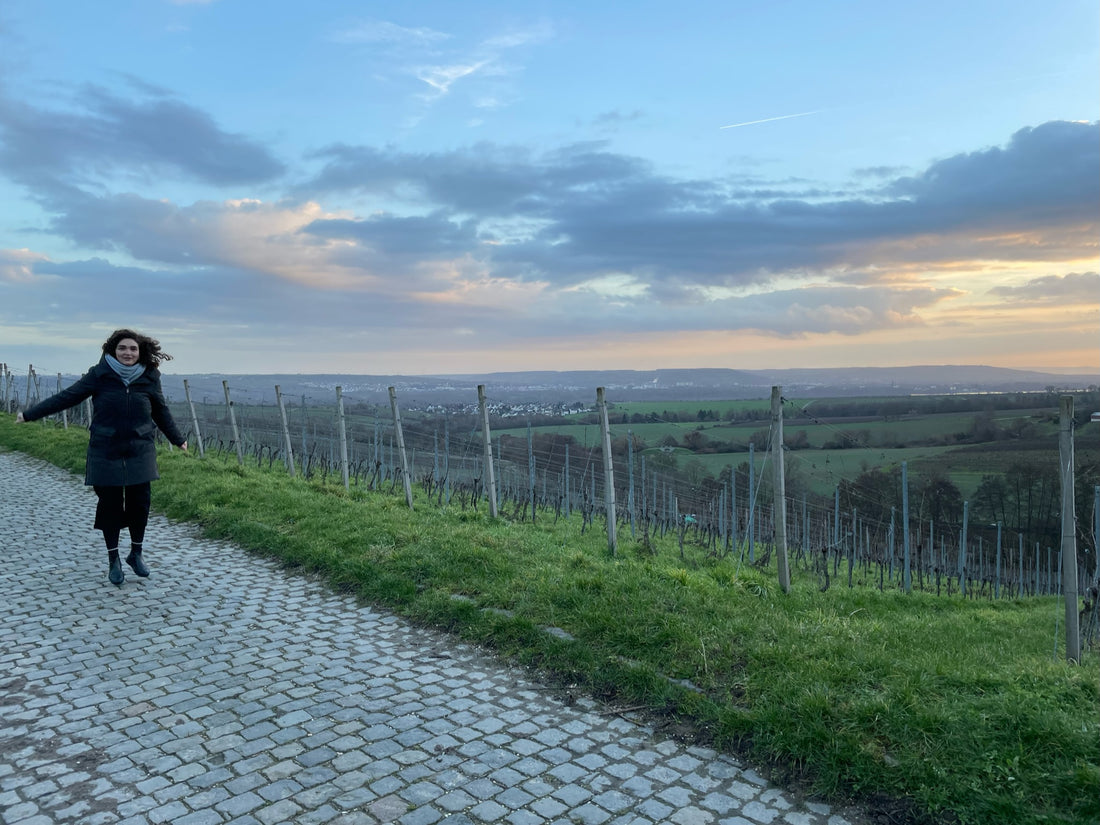
February Visit to Rheingau
As a child, my grandparents would take me to the countryside home only in the warm months and I never had the chance to see what happens in the vineyard in the dormancy months. I love this use of this word to describe the “sleepy” months when the vine is resting before yet another fruity fruitful season. After the WSET 3 course, I was even more eager to see how it is done in practice rather than just knowing the theory.
As we were traveling to Frankfurt am Main anyway, I contacted a few vineyards in Rheingau and asked them if the do such classes (vine pruning is quite a delicate matter to leave in the hands of interns) and I was lucky enough that Kloster Eberbach actually had one single pruning workshop happening exactly the same weekend I was going. I subscribed (and dragged my husband into it) and off we went.
On Saturday morning we drove about 40 minutes to the Kloster, where we were greeted by their really friendly staff and our teacher for the day, Carsten. We were a group of only 8 people from completely different backgrounds and this made the experience even more pleasant. Carsten introduced us to the principles of pruning and while we enjoyed a glass of their own Sekt (German for Sparkling wine, in this case, traditional method), we were given scissors and gloves and some final important details.
We went straight to the vineyard, a small plot that is located within the walls of the monastery and called “the show vineyard”. They don’t actually make wine from these vines (they have 200 other hectares located all over Rheingau) so the pressure was all of a sudden lower. Carsten showed us how it is done, how to decide which cane to keep for this year’s production, how to cut, where to cut, how many “eyes” or better-said buds to leave, how to remove the cut parts etc.

I was very confused in the beginning because on the same row, there were some head-trained vines, some vines that had been guyot in the previous year, but also some cordon-trained vines. As I never paid attention to it before and only learned from the books, in my imagination each row would be trained similarly so I had to reset my mindset while focusing on understanding the full-blast Rebschnittkurs aud Deutsch (vine pruning in german) with local accent of course. After a few examples, we each had to choose our own plant, think what to do, present the options and reasons to Carsten, and then we could cut. We did this a few times on our own, or sometimes we would just gather around one of us to hear Carsten’s reasoning and learn from each other.
The sun was shining (after weeks of grey skies), the mood was just right and I felt I couldn’t be in a better place than there, doing anything else but that. I could have gone on for hours, but lunch was ready so we all went into their wine shop and had lunch and Riesling and continued chatting. We told our colleagues about Pointer and there was a lot of interest for possible events in the area. I unfortunately completely forgot to take a Pointer Glass with me (sometimes my business brain takes off on weekends), but luckily Instagram and all other online tools are always on my phone.
After lunch, we ended up spontaneously booking a tour of their cellar and we decided to squeeze in another tasting before that. We drove 10 minutes down to the Rhein and then to the Wein und Sektgut Barth, a quite small producer I wanted to visit for a while. They are the first VDP Wine Estate to create a sparkling wine from a VDP.Grosses Gewächs® (German Grand Cru). They practice eco-friendly vineyard cultivation, tending to their vineyards with our next generation in mind. It was easy to foresee that I would fall in love with everything I taste and within seconds I was already dreaming of having a bubbly picnic with Pointer Wine Glass Champagne in their vineyard.

Luckily for us, they were open and we were greeted by a really friendly member of the staff who guided us through 5 different sparkling delights. Had we had no time pressure, I would have probably gone through the whole menu. Here is what we tasted (and what we also shipped to Berlin yum yum):
- Riesling Extra Brut - really nice and easygoing, entry-level priced, a bit too sweet for my taste but I know several of you would love it, 100% vegan;
- Ultra Pinot - 100% Pinot Noir - Blanc de Noirs, Brut Nature (my favorite style for sparkling just like the Romanian sparkling wines we have on our website) - in this case only 1.1g of rest sugar), having spent 72 months in the bottle for the second fermentation
- Schützenhaus Riesling VDP Erste Lage - 2nd from the top Sekts Barth produces, totally blew my mind and mouth away, Brut Nature again (this time 2.5g rest sugar), single vineyard, named by Falstaff best Riesling of 2020 and 2022; base wine is first aged 100% in oak before moving to bottle fermentation for 60 months; absolutely stunning, ordered 3 bottles to Berlin;
- B-Nat - the Barth Pet Nat (meaning ancestral method - single fermentation that happens partially in tank and then finished in the bottle); very fresh, only 1.8g rest sugar and 100% Cabernet Sauvignon; 2 bottles traveling to Berlin right now
- Pinot Noir Rotsekt - absolutely stunning, probably the first Pinot Noir Sparkling I ever tried, 8.3g of rest sugar which I DID NOT mind at all; was not Casimir's favorite so only one bottle is coming to Berlin and it shall only be mine.

We quickly drove back up to Steinberg, one of the 6 domains (or vineyards) belonging to Kloster Eberbach, where the cellars are located. We were greeted again by a very friendly guide (and a really friendly colleague from the pruning course who is actually a guide herself at Steinberg) and fresh Sekt sparkling in the glasses. The sun also came out for us and we started the tour on the terrace overlooking the Rhein river, an absolutely gorgeous spot surrounded by vineyards.
It all looked so small and well integrated into the landscape that I thought OK, where do they have space to process the grapes coming from 200 hectares? Our guide explained that we were actually standing on top of a huge cellar completely buried under the vineyard, going 15 meters and 3 stories below ground level, impressively built by architects FRIEES+MOSTER who found a way to bring natural light to all the floors of the cellar (my architect’s heart skipped a beat I must say).

We embarked on a tour through the different areas of the cellar, on each floor a different wine waiting for us: a Spätburgunder (german for Pinot Noir) in the room with the vats for red wine fermentation, a Riesling one floor below next to the vats for white wine fermentation and one last Großes Gewächs Riesling (Rauenthaler Baikenkopf from 2019) in the room with old oak barrels. The perfect closure for my Rheingau immersion came with dinner at Eltville Klostermühle (was not our first dinner option but ALL the other places in the area were fully double booked as the next day was the start for Rhein Gourmet & Wine festival).

I cannot wait to go back and explore other wine producers, summer temperatures, and beautiful sundowners. I also look forward to hopefully organizing some Pointer picnics in the vineyards, but have no fear: you’ll be the first ones to find out.
